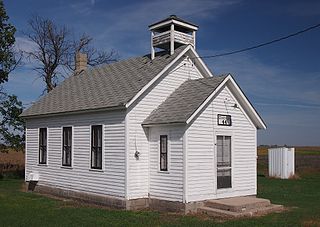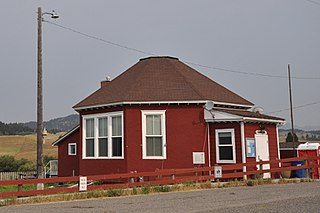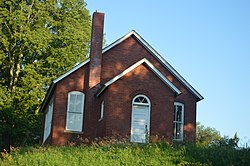
The Avery Coonley House, also known as the Coonley House or Coonley Estate was designed by architect Frank Lloyd Wright. Constructed 1908-12, this is a residential estate of several buildings built on the banks of the Des Plaines River in Riverside, Illinois, a suburb of Chicago. It is itself a National Historic Landmark and is included in another National Historic Landmark, the Riverside Historic District.

One-room schools were commonplace throughout rural portions of various countries, including Prussia, Norway, Sweden, the United States, Canada, Australia, New Zealand, the United Kingdom, Ireland, and Spain. In most rural and small town schools, all of the students met in a single room. There, a single teacher taught academic basics to several grade levels of elementary-age children. While in many areas one-room schools are no longer used, it is not uncommon for them to remain in developing nations and rural or remote areas. Examples include remote parts of the American West, the Falklands, and the Shetland Islands.

Chana School is a Registered Historic Place in Ogle County, Illinois, in the county seat of Oregon, Illinois. One of six Oregon sites listed on the Register, the school is an oddly shaped, two-room schoolhouse which has been moved from its original location. Chana School joined the Register in 2005 as an education museum.

The Charter Oak Schoolhouse is a historic octagonal school building in Schuline, Illinois, located on the Evansville/Schuline Road between Schuline and Walsh. Built in 1873, it served as a public primary school until 1953. The school was one of 53 octagonal schoolhouses built in the United States, of which only three survive. The building is now used as a museum by the Randolph County Historical Society and is listed on the National Register of Historic Places.

The District #2 Schoolhouse, known locally as the Garfield School and also known as Brunswick District No. 2 School, located in Brunswick, New York, United States, is a two-room schoolhouse built and opened in 1881. It hosted local students until the consolidation of Brunswick (Brittonkill) Central School District in the mid-1950s. It was added to the National Register of Historic Places (NRHP) in 1988, becoming the first building in the Town of Brunswick to be added to the Register. It is the current home of the Brunswick Historical Society.

Ourant's School is a one-room schoolhouse located on Ourant Road, east of Deersville, Ohio. The schoolhouse was placed on the National Register on 1994-03-17.

Indian Rock Schoolhouse, also known as District 3 Schoolhouse or Webutuck Country Schoolhouse, is located on Mygatt Road in the hamlet of Amenia, New York, United States. It is a wooden one-room schoolhouse built in the mid-19th century in accordance with a standard state plan for small rural schools that reflected contemporary educational reform movements.

Butler School is a historic building in Oak Brook, Illinois. Frank Osgood Butler donated the land for the two-room schoolhouse in the late 1910s. The building became a meeting place for locals, and hosted the first club to use the term "Oak Brook" to refer to the surrounding settlement. The former school was briefly used as the village hall, police station, and library, until new buildings were constructed for those purposes in the 1970s. It was added to the National Register of Historic Places in 2003.

The McAuley School District No. 27 is a schoolhouse in Winfield Township, DuPage County, Illinois, 1.25 miles (2.01 km) west from West Chicago, Illinois. By the time the schoolhouse was added to the National Register of Historic Places in 1982, District 27 was the last fully functioning one-room school district in Illinois. The final schoolhouse was built in 1913 on a school lot used since the 1850s; it closed in 1991 and the school district annexed into West Chicago Elementary School District 33 in 1992.

The Erin–Warren Fractional District No. 2 Schoolhouse, also known as the Halfway Schoolhouse, is a school building located at 15500 Nine Mile Road in Eastpointe, Michigan, United States. It was listed on the National Register of Historic Places in 2001 and designated a Michigan State Historic Site in 1990.

Strang School District No. 36, or the Strang Public School, is a historic school located in Fillmore County, Nebraska, in the village of Strang. The school is one of the two sites listed on the National Register of Historic Places in the village of Strang. The school building is a small, two-story, brick public schoolhouse, which was built to replace the schoolhouse that was previously located on that site. The schoolhouse was built between 1929 and 1930, and replaced the previous schoolhouse, which burned down in 1928. The schoolhouse still retains all original building materials. The school served high school students from 1930 to 1951, and still functions as a school today, serving grades K–8. The NRHP listing also includes a flagpole located outside the schoolhouse, and five pieces of playground equipment.

The Glen Carbon Grade School is a historic school building located at 124 School Street in Glen Carbon, Illinois. The two-story brick school has a Romanesque-influenced design planned by John William Kennedy. The school was built in 1914 to replace Glen Carbon's one-room schoolhouse, which its student population had outgrown. A four-room frame building supplemented both the old and new schools, so Glen Carbon had eight classrooms in total with its new school. Grades one through four were taught in the new building, while the upper grades used the frame building. The school was part of the Edwardsville school district, and students who wished to attend high school did so in Edwardsville. Glen Carbon was a European immigrant community, and its students reflected the village's wide variety of ethnic groups. The parents of the village, who mainly worked as coal miners, often volunteered for school events. When a new school opened in 1954, the village purchased the building for office space; it now houses the Glen Carbon Historical Museum.

District No. 44 School is a historic one-room school in Taylor Township, Minnesota, United States. It was built in 1891 and used until 1954. The school building was listed on the National Register of Historic Places in 2011 for having local significance in the theme of education. It was nominated for being a well-preserved example of the one-room schoolhouses once common in rural Traverse County.

Point School was a one-room schoolhouse located at 6976 N. Vincennes Trail near Grant Park, Illinois. The school was built in 1854 to serve Yellowhead Township District #8, one of nine school districts in the county. As was typical of Midwestern one-room schoolhouses, the school was a white rectangular frame building; it featured a gable front and three windows along each of the sides. The school operated until 1948, when it was closed due to school consolidation in the area. While Kankakee County once had 151 one-room schoolhouses, an Illinois Historic Preservation Agency survey in 1992 determined that the Point School was one of only three one-room schoolhouses that still stood at its original site and had not been significantly altered.

The North Grove School is a historic one-room schoolhouse located at 26475 Brickville Road northwest of Sycamore, Illinois. Swedish immigrants built the school in 1878; while it was originally a Lutheran school, it became part of the DeKalb County public school system two years later. The school served area students in the first through eighth grades until 1952, when it closed during a wave of school consolidations. After its closure, the school building was briefly used by the local Community Club. It is the only one-room schoolhouse in DeKalb County that is at its original site and has not been significantly altered.

The Big Woods School is a historic one-room schoolhouse located at 3033 N. Eola Road in Aurora, Illinois. The school was built in 1917-18 to replace the original Big Woods School, which was built in the mid-19th century and had fallen into disrepair. The red brick school building has a Craftsman design. It was one of the first schoolhouses in DuPage County built after Illinois' Sanitation Law of 1915, which created a set of modern safety and sanitation standards for the state's public schools. The school's plan is essentially the same as that recommended by the state, with considerations for playground space, lighting, ventilation, and indoor plumbing. In 1963, the school closed due to consolidation with two nearby schools, and the building was sold to a private owner; it is now owned by a not-for-profit preservation group.

The Espanola Schoolhouse is a one-story; one-room rural school building that has survived from the Jim Crow racial segregation-era. It is the last standing one-room schoolhouse in Flagler County. It is located at 98 Knox Jones Avenue, Bunnell, Florida 32110.

Glenwood School is a historic one-room schoolhouse at 1398 East 800 North Road in rural Ash Grove Township, Iroquois County, Illinois, near the village of Cissna Park. The school opened in 1887, shortly after compulsory public schooling laws in Illinois spurred a wave of rural school construction. The school's appearance is typical of vernacular one-room schoolhouses, with a rectangular plan, a symmetrical front facade with a gable, and an entrance vestibule leading into the classroom. Later changes to the school building, such as a heating system and concrete sidewalks, were likely the result of statewide school modernization efforts in the 1910s. Like most rural areas, Iroquois County consolidated its schools in the 1930s and 1940s, and the Glenwood School was a victim of this trend; a sign above its entrance suggests it closed in 1936. It is the only remaining one-room schoolhouse in Ash Grove Township, which once had nine public schools.

A two-room schoolhouse is a larger version of the one-room schoolhouse, with many of the same characteristics, providing the facility for primary and secondary education in a small community or rural area. While providing the same function as a contemporary primary school or secondary school building, a small multi-room school house is more similar to a one-room schoolhouse, both being architecturally very simple structures. While once very common in rural areas of many countries, one and two-room schools have largely been replaced although some are still operating. Having a second classroom allowed for two teachers to operate at the school, serving a larger number of schoolchildren and/or more grade levels. Architecturally, they could be slightly more complex, but were still usually very simple. In some areas, a two-room school indicated the village or town was wealthier and more prosperous.

The Malmborg School in Bozeman, Montana is a one-room schoolhouse and the only octagonal school in Montana. Built in 1905, the schoolhouse is an example of the octagonal schools commonly found in the Mid-Atlantic and associated with mid-nineteenth-century reformer Orson Fowler's promotion of the “Octagon Mode of Building” in his book, A Home for All. The octagonal design of the school allowed for greater interior area and increased natural lighting, with windows present on three of the school's walls. The original school also featured an open front porch and an open bell tower, which were enclosed and removed in later renovations. The Malmborg School survived the consolidation of school districts and subsequent decline of one-room schoolhouses beginning in the 1920s and is still operational today as a K-8 school, with 12 students and 1 teacher in the 2019–2020 school year. The school was listed on the National Register of Historic Places on July 21, 1981. It was one of thirteen one-room schoolhouses listed together on the register on this date in Gallatin County, Montana. Three additional one-room schoolhouses in Gallatin County were listed on the register later.






















